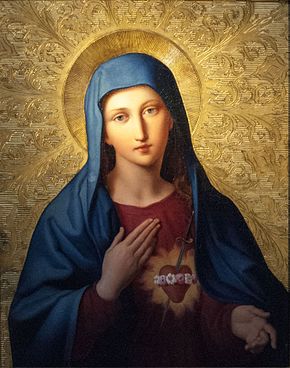Our Lady in Advent
| Blessed Virgin Mary | |
|---|---|

"The Church's devotion to the Blessed Virgin is intrinsic to Christian worship."
|
|
| Mother of God, Queen of Heaven, Mother of the Church, Mediatrix, Co-Redemptrix, Our Lady | |
| Born | September 8 (Nativity of Mary) |
| Venerated in | Catholic Church |
| Canonized | Pre-Congregation |
| Major shrine | Santa Maria Maggiore, others (see Shrines to the Virgin Mary) |
| Feast | See Marian feast days |
| Attributes | Blue mantle, white veil, Immaculate heart, crown of 12 stars, pregnant woman, halo with 12 stars, roses, woman with child |
| Patronage | See Patronage of the Blessed Virgin Mary |
In the Catholic Church, the veneration of Mary, mother of Jesus, encompasses various Marian devotions which include prayer, pious acts, visual arts, poetry, and music devoted to the Blessed Virgin Mary. Popes have encouraged it, while also taking steps to reform some manifestations of it. The Holy See has insisted on the importance of distinguishing "true from false devotion, and authentic doctrine from its deformations by excess or defect". There are significantly more titles, feasts, and venerative Marian practices among Roman Catholics than in other Christian traditions. The term hyperdulia indicates the special veneration due to Mary, greater than the ordinary dulia for other saints, but utterly unlike the latria due only to God. The term "Mariolatry" is a Protestant pejorative label for perceived excessive Catholic devotion to Mary. Other, non-critical, terms for the veneration are Marianism and Marism. Derived terms, referring to someone who venerates Mary, are Marian, Marianist, and Marist.
Belief in the incarnation of God the Son through Mary is the basis for calling her the Mother of God, which was declared a dogma at the Council of Ephesus in 431. At the Second Vatican Council and in Pope John Paul II's encyclical Redemptoris Mater, she is spoken of also as Mother of the Church.
Growth of Roman Catholic veneration of Mary and Mariology has often come not from official declarations, but from Marian writings of the saints, popular devotion, and at times reported Marian apparitions. The Holy See approves only a select few as worthy of belief; most recently the 2008 recognition of apparitions as far back as 1665.
...
Wikipedia
